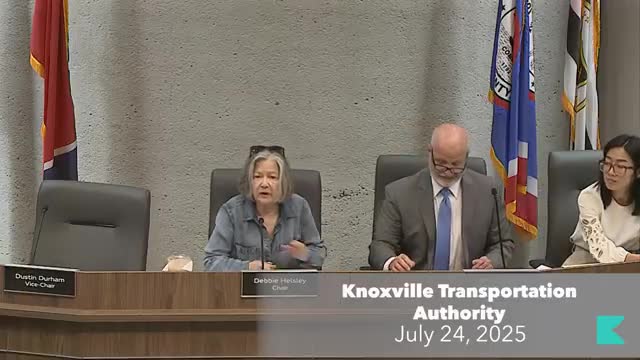New Title VI Analysis Shows Positive Changes for Route 1 Transit in Urban Area
July 26, 2025 | Transportation Authority Meetings, Knoxville City, Knox County, Tennessee
This article was created by AI summarizing key points discussed. AI makes mistakes, so for full details and context, please refer to the video of the full meeting. Please report any errors so we can fix them. Report an error »

The City of Knoxville's recent government meeting focused on significant changes to local transit routes, specifically Routes 1 and 16, as part of compliance with federal regulations. The discussion highlighted the Title VI analysis, which assesses the impact of service changes on minority and low-income populations.
Pat, a representative from the transit authority, explained that due to federal funding and the operation of over 50 fixed-route buses in an urban area with a population exceeding 200,000, the city is required to conduct a Title VI program. This program mandates that any service change affecting 25% or more of transit route miles or revenue vehicle miles is classified as a major service change.
Route 1, known as the downtown connector, was identified as a major service change with a total service change of 36.9%, significantly exceeding the 25% threshold. However, the analysis indicated that this change would positively impact the community without adversely affecting minority or low-income populations. In contrast, Route 16's changes represented only a 0.72% service change, thus not qualifying as a major change.
The meeting also included a review of maps illustrating the demographic impact of the changes. The analysis showed that while Route 1 would affect minority populations, it would not result in significant adverse effects. The accrual of benefits analysis revealed that 51% of the minority population would benefit from the changes, an increase of approximately 15% from previous access levels. Similarly, low-income populations would see a 17% increase in access.
Overall, the meeting underscored the city's commitment to enhancing public transit services while ensuring equitable access for all community members, particularly those from minority and low-income backgrounds. Further discussions and questions were encouraged to clarify the implications of these changes.
Pat, a representative from the transit authority, explained that due to federal funding and the operation of over 50 fixed-route buses in an urban area with a population exceeding 200,000, the city is required to conduct a Title VI program. This program mandates that any service change affecting 25% or more of transit route miles or revenue vehicle miles is classified as a major service change.
Route 1, known as the downtown connector, was identified as a major service change with a total service change of 36.9%, significantly exceeding the 25% threshold. However, the analysis indicated that this change would positively impact the community without adversely affecting minority or low-income populations. In contrast, Route 16's changes represented only a 0.72% service change, thus not qualifying as a major change.
The meeting also included a review of maps illustrating the demographic impact of the changes. The analysis showed that while Route 1 would affect minority populations, it would not result in significant adverse effects. The accrual of benefits analysis revealed that 51% of the minority population would benefit from the changes, an increase of approximately 15% from previous access levels. Similarly, low-income populations would see a 17% increase in access.
Overall, the meeting underscored the city's commitment to enhancing public transit services while ensuring equitable access for all community members, particularly those from minority and low-income backgrounds. Further discussions and questions were encouraged to clarify the implications of these changes.
View full meeting
This article is based on a recent meeting—watch the full video and explore the complete transcript for deeper insights into the discussion.
View full meeting
